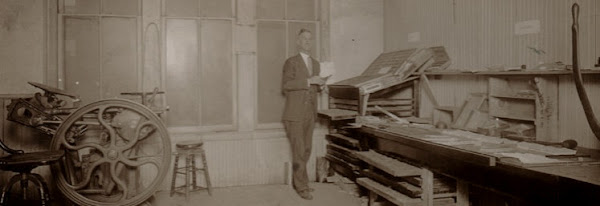The weekend began Saturday morning (of course) when I drove with my friend Alan to northern New Jersey to pick up some presses and other print shop items. Alan does what he calls Letterpress Rescue as part of the Excelsior Press Museum. People cleaning out their parent's house or closing down their print shop often find Alan through his website and ask him if he can come and get their presses and equipment. Sometimes selling the items isn't an option for people and presses are often in the basement or even the attic where scrap metal dealers seldom venture. Instead of them going to the smelter, Alan adds the items to the museum shop or sells them so they will continue their useful lives and help fund the museum.
Thus we found ourselves hauling one C&P 8x12 NS out of a basement and a second out of the garage. In a shed there was some type in cases and about eight 5 gallon buckets of Linotype slugs, leads, and misc. heavy metal. Here's a bit of news: lead is heavy. Both presses had Kimble variable speed motors and were complete and in good shape, though in need of cleaning. Our adventure took the better part of the day and we got home (Alan to Baptistown and me to Milford, NJ) about 5:30.
Sunday morning we were off to the house of Alan's former print shop teacher in east-central New Jersey, a very nice man now 80 years old. Over the course of several weeks we had removed from his basement a C&P 10x15 OS, the press I am trading up to, two 1940/50's vintage Mutilith offset presses, a NuArc platemaker, Challenge paper cutter, type in cases and all the other detritus of a print shop. There was another Challenge electric cutter already in the garage along with a brand-new in the box Spinnet paper drill. Because we had prepped all this previously and had a rental truck with a hydraulic lift gate it didn't take us long to load up.
The next stop was my house where my 8x12 press was waiting on my back porch. On the truck it went and off came the 10x15 and right into the living room. Then back to Alan's shop where we unloaded everything and put it with the haul from Saturday. All in all it was a busy weekend. I plan to begin cleaning my new press this weekend and will hopefully have it running and printing by Christmas. I'm very anxious to move from setting up the shop to printing. The press is very nice and came with 6 chases, a Kimble variable speed motor, and a long and interesting history of job work.
The first photo below shows the two NS presses in front of my OS press in the barn where Alan has his shop, all lined up like soldiers on parade. The second shows a closeup of my old press. The third shows the main frame of my new press after we got it into the living room, otherwise know as my shop. As you can see, it needs some cleaning.
Let me mention that the three 8x12 presses are for sale. I can give you particulars or you can write to Alan directly about specifics and prices through the Excelsior Press website, a link to which is at the right of this blog page. In addition, the two Multilith presses are for sale, one is for parts but the other is complete and running and there are many, many (did I say many?) accessories, blankets, an extra brand-new motor, etc. that go with it. Alan's teacher used it regularly and had large stocks of all needed supplies. Also, both Challenge paper cutters are for sale, they're complete and nice. The paper drill and platemaker with several boxes of new carbon rods and vacuum pump are also for sale. As for me, I'm getting some type, cuts, and ornaments.
So it's not so de-pressing after all, eh?
So it's not so de-pressing after all, eh?










